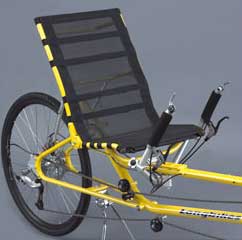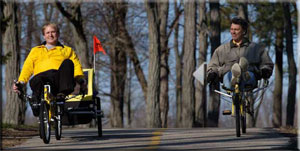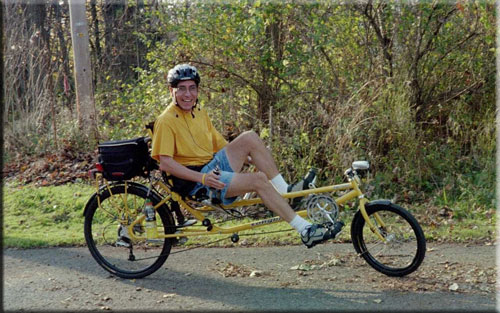|
||
Why an Underseat Steering Recumbent?

There is really only one reason, COMFORT!
With that said, there are many issues in addressing comfort. They can be muscular, skeletal, or neurological and run from the bottom of the pelvis to the tips of your fingers.
Perhaps the first report that I got back from a customer almost ten years ago was about the first tour they had taken their new Duplex tandem on, a supported tour around Lake Michigan. The tour company had arranged for lunch stops at local schools where the riders went to the lunch room and sat down on the chairs or benches and typically responded with lots of pleasant aahs. Our Duplex duo were not thrilled with the hard surfaces after having been on their comfy mesh seats for a few hours and instead made an unpleasant ooh instead. The buttock to the neck is just one region of the body which can experience discomfort … just about any recumbent will be an improvement over a standard bicycle saddle.
Underseat steering goes way beyond what most recumbents will do for comfort. Our version of USS provides hand and arm positioning unlike any other bike in the world, including the best of the best European bikes. There are two types of USS, direct and indirect. Direct is best thought of as a handle bar mounted to the back side of the fork and extending back far enough to drop your arms straight down beside the seat and grab on. A couple of the drawbacks to this design are hand position and interference with the seat in sharp turns.
Longbikes uses an indirect steering. Indirect in that the handle bar is mounted to the frame and uses linkage (in automotive terms, a drag link) to connect to the fork. A couple of advantages are that the steering ratio or speed can be adjustable and the handle bar rotates about a pivot point under the seat. The ends of the handle bar move in an arc beside your legs, with a movement that is essentially a push pull by the rider.  Rarely will you ever have any interference with the seat or your legs. The big benefit is that because of the movement at the end of the handle bar, we can use bar end extension that extend up beside your legs and have almost infinite positioning adjustment in two axes. This allows you to position your forearm and hand in a neutral relaxed position. When I have the opportunity to fit a customer on their bike, I bring the controls to the hands avoiding any cocking of the wrist and adjust the brake and shift levers to be in line with the hand.
Rarely will you ever have any interference with the seat or your legs. The big benefit is that because of the movement at the end of the handle bar, we can use bar end extension that extend up beside your legs and have almost infinite positioning adjustment in two axes. This allows you to position your forearm and hand in a neutral relaxed position. When I have the opportunity to fit a customer on their bike, I bring the controls to the hands avoiding any cocking of the wrist and adjust the brake and shift levers to be in line with the hand.
All of this adjustability can drive you a little crazy getting things set perfect, but when you do, you should never experience wrist or shoulder pain again. Comfort is becoming increasingly important, our customers range form their early thirties to the mid eighties. We have a number of customers in their mid 70s who go out for a little ride, 3,000–5,000 miles over a 30 to 60 day period … they don’t do it in discomfort. Bryan Ball, in his Slipstream review many years ago commented that the Slipstream was not a miles per hour bike, but a miles per day bike. An 80 to 100 miles per day for a month or two of riding confirms that. Read David Boyd’s review: He boldly states that his Slipstream changed his life!

♦ 1500 W. Hampden Ave., Bldg. 3 Unit C, Englewood, CO 80110 — Phone: 303-986-9300 ♦ |



